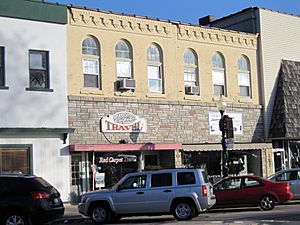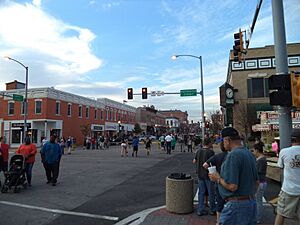Morris, Illinois facts for kids
Quick facts for kids
Morris
|
|
|---|---|

|
|

Location of Morris in Grundy County, Illinois.
|
|

Location of Illinois in the United States
|
|
| Country | United States |
| State | Illinois |
| County | Grundy |
| Townships | Morris, Erienna, Saratoga, Wauponsee |
| Founded | 1842 |
| Area | |
| • Total | 11.64 sq mi (30.15 km2) |
| • Land | 11.28 sq mi (29.22 km2) |
| • Water | 0.36 sq mi (0.93 km2) |
| Elevation | 515 ft (157 m) |
| Population
(2020)
|
|
| • Total | 14,163 |
| • Density | 1,255.25/sq mi (484.65/km2) |
| Time zone | UTC-6 (CST) |
| • Summer (DST) | UTC-5 (CDT) |
| ZIP Code(s) |
60450
|
| Area codes | 815/779 |
| FIPS code | 17-50491 |
| GNIS feature ID | 2395407 |
| Wikimedia Commons | Morris, Illinois |
Morris is a city in Grundy County, Illinois, United States. It is the main city, or county seat, of Grundy County. Morris is also part of the area southwest of Chicago. In 2020, about 14,163 people lived there.
Contents
Discover Morris: A Great Place to Live
Morris is an important city in Grundy County. It has a large hospital and modern schools. The city is proud of the Morris Community High School Redskins football team, which has won three state championships!
You can find many fun places in Morris. There are small parks, baseball fields, and tennis courts. The city also has two golf courses, an outdoor swimming pool, and a large indoor pool. For nature lovers, there's Gebhard Woods State Park and William G. Stratton State Park. You can launch boats on the Illinois River from Stratton State Park. Near White Oak elementary school, there's a skatepark.
Morris Community High School is built on top of an old mining network. This network stretches for about 5 miles (8 kilometers) underground!
The downtown area of Morris is very special. It was even ranked as one of the top Main Streets in Illinois! Downtown Morris has more than 30 unique shops and restaurants that are owned by local people.
Where is Morris Located?
Morris is in the northeast part of Grundy County. It sits along U.S. Route 6 and Illinois Route 47. The city is on the north side of the Illinois River. Its elevation is about 515 feet (157 meters) above sea level.
The total area of Morris is about 11.64 square miles (30.15 square kilometers). Most of this area, about 11.28 square miles (29.22 square kilometers), is land. The rest, about 0.36 square miles (0.93 square kilometers), is water.
Morris Weather: What's the Climate Like?
Morris gets about 40 inches (100 cm) of rain and snow each year. The hottest temperature ever recorded in Morris was 109°F (43°C) on July 14, 1936. The coldest was -26°F (-32°C) in December 1924.
In July, the average high temperature is around 84.5°F (29.2°C). In January, the average low temperature is about 15.4°F (-9.2°C).
Morris usually doesn't get hit by major tornadoes, even though they happen in Northern Illinois every year. The city was affected by the huge 1974 Super Outbreak of tornadoes in April 1974. Luckily, the damage in Morris was small, and no one was hurt.
Sometimes, Morris can get a lot of snow and even blizzards.
| Climate data for Morris, Illinois (1991–2020 normals, extremes 1912–present) | |||||||||||||
|---|---|---|---|---|---|---|---|---|---|---|---|---|---|
| Month | Jan | Feb | Mar | Apr | May | Jun | Jul | Aug | Sep | Oct | Nov | Dec | Year |
| Record high °F (°C) | 68 (20) |
71 (22) |
85 (29) |
93 (34) |
103 (39) |
106 (41) |
109 (43) |
107 (42) |
103 (39) |
95 (35) |
82 (28) |
72 (22) |
109 (43) |
| Mean daily maximum °F (°C) | 31.2 (−0.4) |
35.6 (2.0) |
47.7 (8.7) |
60.9 (16.1) |
72.1 (22.3) |
81.7 (27.6) |
84.9 (29.4) |
82.7 (28.2) |
77.4 (25.2) |
64.4 (18.0) |
49.0 (9.4) |
36.7 (2.6) |
60.4 (15.8) |
| Daily mean °F (°C) | 23.4 (−4.8) |
27.4 (−2.6) |
38.3 (3.5) |
50.3 (10.2) |
61.6 (16.4) |
71.4 (21.9) |
75.0 (23.9) |
72.8 (22.7) |
66.1 (18.9) |
53.6 (12.0) |
40.3 (4.6) |
29.1 (−1.6) |
50.8 (10.4) |
| Mean daily minimum °F (°C) | 15.7 (−9.1) |
19.3 (−7.1) |
28.9 (−1.7) |
39.6 (4.2) |
51.0 (10.6) |
61.2 (16.2) |
65.0 (18.3) |
63.0 (17.2) |
54.8 (12.7) |
42.8 (6.0) |
31.6 (−0.2) |
21.5 (−5.8) |
41.2 (5.1) |
| Record low °F (°C) | −23 (−31) |
−22 (−30) |
−19 (−28) |
12 (−11) |
24 (−4) |
34 (1) |
41 (5) |
34 (1) |
26 (−3) |
12 (−11) |
−9 (−23) |
−56 (−49) |
−26 (−32) |
| Average precipitation inches (mm) | 2.09 (53) |
1.79 (45) |
2.23 (57) |
3.34 (85) |
4.39 (112) |
4.72 (120) |
4.92 (125) |
4.01 (102) |
3.55 (90) |
3.23 (82) |
2.50 (64) |
2.02 (51) |
38.79 (985) |
| Average snowfall inches (cm) | 7.4 (19) |
7.5 (19) |
2.9 (7.4) |
0.5 (1.3) |
0.0 (0.0) |
0.0 (0.0) |
0.0 (0.0) |
0.0 (0.0) |
0.0 (0.0) |
0.0 (0.0) |
1.1 (2.8) |
5.3 (13) |
24.7 (63) |
| Average precipitation days (≥ 0.01 in) | 10.0 | 8.2 | 9.2 | 10.8 | 13.4 | 11.2 | 9.3 | 9.5 | 8.1 | 10.2 | 8.1 | 9.4 | 117.4 |
| Average snowy days (≥ 0.1 in) | 5.9 | 4.3 | 1.8 | 0.5 | 0.0 | 0.0 | 0.0 | 0.0 | 0.0 | 0.1 | 1.0 | 4.0 | 17.6 |
| Source: NOAA | |||||||||||||
Who Lives in Morris?
| Historical population | |||
|---|---|---|---|
| Census | Pop. | %± | |
| 1860 | 2,105 | — | |
| 1870 | 3,138 | 49.1% | |
| 1880 | 3,486 | 11.1% | |
| 1890 | 3,053 | −12.4% | |
| 1900 | 4,273 | 40.0% | |
| 1910 | 4,563 | 6.8% | |
| 1920 | 4,505 | −1.3% | |
| 1930 | 5,568 | 23.6% | |
| 1940 | 6,145 | 10.4% | |
| 1950 | 6,926 | 12.7% | |
| 1960 | 7,935 | 14.6% | |
| 1970 | 8,194 | 3.3% | |
| 1980 | 8,833 | 7.8% | |
| 1990 | 10,270 | 16.3% | |
| 2000 | 11,928 | 16.1% | |
| 2010 | 13,636 | 14.3% | |
| 2020 | 14,163 | 3.9% | |
| U.S. Decennial Census | |||
In 2020, the city of Morris had 14,163 people living in 6,206 households. About 4,100 of these were families. The population density was about 1,217 people per square mile (470 people per square kilometer).
Most people in Morris are White (about 83%). There are also people who are African American (2.2%), Asian (1.2%), and Native American (0.4%). About 13.3% of the population is Hispanic or Latino.
In Morris, about 31% of households have children under 18. Nearly half (46.5%) of households are married couples. About 12% are single mothers with no husband present.
The average age in Morris is 37.6 years old. About 22.9% of the people are under 18. About 17.6% are 65 years or older.
The average income for a household in Morris was $61,419. For families, the average income was $73,750. About 10.2% of the total population lives below the poverty line. This includes 18.3% of those under 18.
Industries: What Jobs are in Morris?
Morris has a history of different industries. The Allen Paper Car Wheel Works used to be in Morris. From 1867 to 1890, they made special wheels for the Pullman Palace Car Company in Chicago.
By the 1920s, a paper mill in Morris became one of the biggest employers. It made cardboard boxes of all shapes and sizes. These boxes were sent all over the United States.
Today, the Lyondell Chemical Company is about 5 miles (8 kilometers) from the city center. Many Morris residents work there.
Morris is also close to several power plants. The Dresden Nuclear Power Station is only about 3 miles (5 kilometers) away. The LaSalle Nuclear Station is 14-15 miles (22-24 kilometers) away. The Braidwood Generating Station is about 13 miles (21 kilometers) away. All these plants are owned by Exelon Corp.. The Dresden Generating Station helps provide energy for Chicago and nearby areas.
Morris's Telephone History
Morris holds a special place in telephone history! In the early 1960s, the world's first electronic switching system was set up in Morris. This system was a huge step forward in how phone calls were connected.
Before this, telephone operators had to manually connect calls. Then, an automatic system using mechanical parts was installed around 1958. But the new electronic system was different. From 1960 to 1962, a few hundred homes in Morris got phone service from this new electronic system. It used special electronic tubes instead of mechanical parts.
One cool thing about this "Morris System" was its electronic tone ringers. Instead of a traditional bell, your phone would make different tones!
Famous People from Morris
- Jessie Bartlett Davis, (c. 1859–1905), a famous opera singer and actress.
- Jack Boyle, (1889–1971), played third base for the Philadelphia Phillies baseball team.
- Ed Brady, (b. 1960), a former NFL linebacker.
- Kelly Dransfeldt, (b. 1975), played shortstop for the Texas Rangers and Chicago White Sox baseball teams.
- Careen M. Gordon, (b. 1972), served in the Illinois House of Representatives from 2003 to 2011.
- Philip C. Hayes, (1833–1916), a congressman (a member of the U.S. Congress).
- Albert Kingsbury, (1863–1943), an engineer, inventor, and business owner.
- Eric J. Magnuson, (b. 1951), a lawyer and former Chief Justice of the Minnesota Supreme Court.
- Billy Petrick, (b. 1984), a former pitcher for the Chicago Cubs baseball team.
- Walter M. Pierce, (1861–1954), a congressman from Oregon and the 17th governor of Oregon.
- Lyman Beecher Ray (1831–1916), served as lieutenant governor of Illinois from 1889–1893. He was also a politician and shopkeeper in Morris.
- Scott Spiezio, (b. 1972), a former Major League Baseball third baseman.
- Ronald Steel, (b. 1931), an award-winning writer, historian, and professor.
- James R. Washburn (1921–2007), an Illinois state representative and mayor of Morris.
- Jerry Weller, (b. 1957), a former congressman from Illinois.
Images for kids
See also
 In Spanish: Morris (Illinois) para niños
In Spanish: Morris (Illinois) para niños





